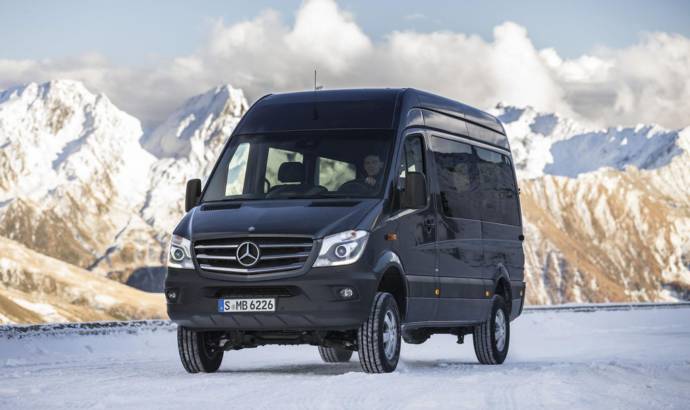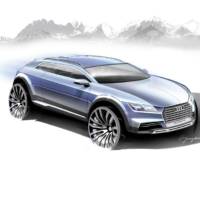The new Sprinter 4×4 provides that decisive extra traction under tough conditions. The Sprinter 4×4 crewbus is at home transporting hotel guests to snowy Alpine resorts while the panel van can convey work crews, materials and tools to wind turbines in wet fields. The crewcab can pull construction machinery out of pits, and the chassis with camper van body can take adventurers across rocky or sandy deserts.
The Sprinter 4×4 is an all-wheel-drive van for professionals rather than the boulevard. Its home terrain? Construction sites, mountains, snowy regions and natural landscapes. And it covers an equally wide range of industries: construction, building materials, energy supply, forestry, the hotel business and, last but not least, people with a thirst for adventure.
As a true professional, the Sprinter 4×4 makes life as easy as possible for its driver. Its all-wheel drive can be engaged at the press of a button, whereupon the 4ETS electronic traction system takes over. The driver simply needs to make well-judged use of accelerator and steering wheel while the technology takes care of the rest. The all-wheel drive is integrated into the standard-fit Electronic Stability Program ESP and complements the safety systems perfectly.
The Sprinter 4×4 now comes with the option of Downhill Speed Regulation (DSR), which ensures that a preselected speed is maintained constantly when driving downhill. This is possible thanks to the interaction between the engine, transmission and specifically targeted brake actuation. DSR is activated using a button in the cockpit. The speed is then controlled using the stalk for the cruise control – the prerequisite for DSR.
As a further option, Mercedes-Benz can equip the Sprinter 4×4 with Hill-Start Assist and off-road tyres with extremely deep tread. Plus the Sprinter 4×4 can be individualised by choosing from the familiar array of optional extras.
In keeping with the Sprinter 4×4 van’s areas of application, the all-wheel-drive system has a professional configuration based on the Mercedes-Benz 4ETS electronic traction system. This technology is also used in the Vito 4×4, Mercedes-Benz passenger cars, and the ML-Class and GL-Class off-roaders.
In contrast to other models, however, the Sprinter’s all-wheel drive is engageable so as to cover the wide range of conditions under which the van has to operate. Furthermore, this technology minimises fuel consumption in everyday use.
The all-wheel drive can be engaged when the engine is running, either when the vehicle is stationary or at low speeds of up to 10 km/h, using a switch on the instrument panel. In this case, an electric motor engages a pair of spur gears in the transfer case. An indicator lamp in the switch informs the driver that the all-wheel drive is engaged.
In contrast to other systems of this type, the Sprinter’s engageable all-wheel drive does not provide a rigid through-drive. The power is transmitted variably, all the components of the standard-fit Adaptive ESP remain operational even when all-wheel drive is selected, and the acceleration skid control (ASR) is likewise activated.
When all-wheel drive is engaged, the drive power of the Sprinter 4×4 is split 35:65 between the front and rear axles in normal operation, ensuring handling performance practically on a par with the Sprinter’s usual rear-wheel drive in everyday operation.
The Sprinter 4×4 model’s all-wheel-drive system works with the electronic traction system 4ETS instead of with mechanical differential locks: should one or more of the wheels lose traction on slippery ground, 4ETS brakes the spinning wheels automatically with short pulses and, consequently, increases the drive torque at the wheels offering good traction by the same amount.
To do this, 4ETS uses the ABS wheel sensors. Automatic brake application by means of 4ETS has the same effect as up to three differential locks: the interaxle lock, the rear axle lock and the front axle lock.
The engineers have flange-mounted the transfer case directly onto the main transmission, while the front-axle drive has been kept very compact. It has a lifetime oil fill and, like the additional front-axle drive shafts, requires no maintenance.
Although the Sprinter 4×4 is not an off-roader, its raised body (by 110 mm at the front and by 80 mm at the rear) endows it with characteristics similar to those of a cross-country vehicle.
By way of example, the approach angle of the Sprinter with a gross vehicle weight of 3.5 t is 28 degrees instead of 18 degrees in the conventional rear-wheel-drive Sprinter while, in the panel van with short overhang, the departure angle is 27 degrees (conventional drive: 22 degrees). The breakover angle – which is important for driving over humps – is 25 degrees in the standard-wheelbase Sprinter 4×4 instead of the usual 17 degrees. Depending on engine version, the slope climbing ability is around 20 percent higher than in the Sprinter with conventional drive. Equally impressive, at 610 mm, is the Sprinter 4×4’s fording depth (Sprinter 4×2: 500 mm).
Because the body is raised, the familiar additional turn signal lamps in the exterior rear view mirrors would be above the maximum statutory height. For this reason, the Sprinter 4×4 is provided with side turn signal indicator lamps in the front side panels of the body. For the same reason, the panel van and crewbus versions have their rear fog lamp and rear reversing light integrated in the bumper.



